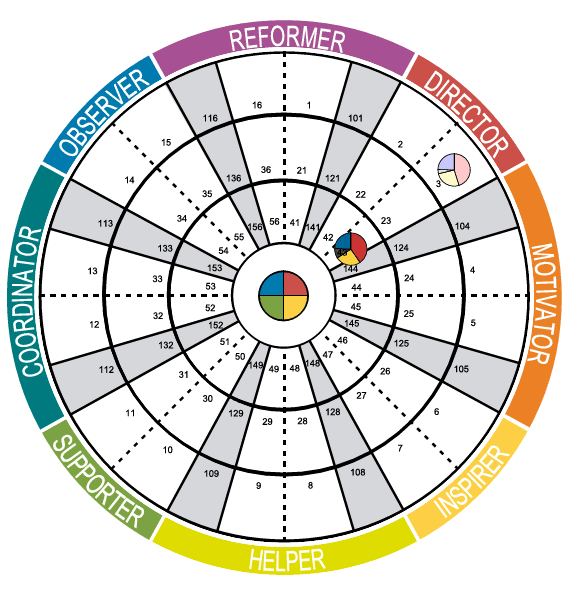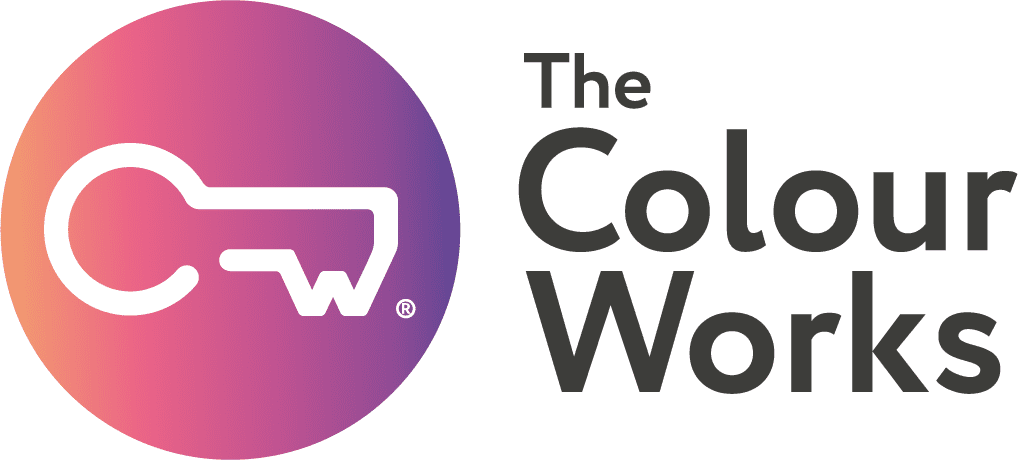Getting the most out of your profile
Your Insights
Discovery Profile
Your Insights Discovery profile:
- Is unique to you
- Can be used to bring about profound personal development
- Is a great coaching tool – when using it in this way, it can be a good idea to ask for feedback from people who are very different from you. (For example, if your dominant preferred energies are Red and Blue, ask for feedback from someone who you know (or feel) has dominant Green and Yellow energies).
It’s important to remember:
- Your profile describes you, it doesn’t define you. It is not designed to be used as a defensive weapon; it is designed to help you improve your own effectiveness and the effectiveness of your relationships, particularly with those people who are most different from yourself.
- No position is ‘better’ or ‘worse’ than another. There are just different approaches! Versatility is being able to adapt to the needs of self, others and the environment. It is possible for a person in any position on the wheel to do this competently.
Overview
One of the main benefits of Insights Discovery is that you can gain an in-depth summary of your work style, how you interact with others and how you make decisions. This section can often hold clues as to why you may be suited to some roles more than others. This section also identifies your unique talents and provides you with a picture of how you may well be perceived in the workplace.
Action (Coaching Opportunity)
You may be inclined to disagree with some aspects of the Insights Discovery profile. Underline these parts and ask for honest feedback from anyone you feel knows you well, both inside and outside work. Additionally, see if you can find a couple of phrases from each section that describe you best and test these out on others too.
Strengths
This list of 10 strengths is not exhaustive, you will have others but these have been highlighted as 10 key areas of strength.
Action (Coaching Opportunity)
Highlight the top 3 as you see them and then ask others to do the same – are they the same as the ones you have highlighted? Knowing the strengths others see in you can give you the confidence to really apply them.
Possible Weaknesses
This list of 10 may actually reflect what is only an overused strength. Nevertheless this list can be incredibly useful in highlighting potential areas for development.
Action (Coaching Opportunity)
Pick what you regard as your top 3 and then ask others to pick their top 3 for you. It can be a good idea to use the following question: ‘If I focused on improving over the next 6 months, which of these areas would have the most impact on me/the team/the business?’
Value to the Team
This section describes some of the ways in which you bring value to the team you are part of. It’s different from strengths in that it is ‘team orientated’ rather than ‘strength orientated’.
Action (Coaching Opportunity)
Again, compare your own perception of your top 3 with what the rest of the team think about you. If the list does not actually reflect the value they see in you, ask them what it is.
Strategies for Communication
These are incredibly useful sections that describe how to communicate with you effectively.
Action (Coaching Opportunity)
Remember, we tend to communicate with others in the way we like to be communicated with, and this is not always a good strategy! So, pick your top 2 from each page, share them and, just as importantly, listen carefully to what’s right for others.
Possible Blind Spots
Be prepared to dig deep in this section as it explores your less conscious side and the effect your less conscious behaviours can have on other people.
Action (Coaching Opportunity)
Test your blind spots for validity by asking colleagues (or friends) for feedback. Which aspect of the feedback would deliver the greatest return to you (either personally or professionally) if you consciously worked on it over the next 6 months?
Recognising Your Opposite Type
This section describes the person who sits opposite you on the Insights Wheel. This is likely to be both the person you find most difficult as well as your best ally.
Action (Coaching Opportunity)
Who is this?! Think about it, both personally and professionally, and start to question your beliefs about any of their traits that may irritate or annoy you. What gifts do they bring to the party that you don’t?
Communication Strategies for your Opposite Type
A simple guide to ‘how to’ and ‘how not to’ communicate with your opposite type.
Action (Coaching Opportunity)
Take this seriously. The golden rule is ‘Do unto others as THEY would have done unto THEM’. This means that, despite your best intentions, your preferred communication style may well be upsetting your Opposite Type and it’s only you who can change it.
Suggestions for Development
This list identifies some potential areas for personal development. You may argue that you have already addressed some of these – because your Insights profile is a reflection of your ‘preferences’, it cannot tell if you are already compensating for an area of development.
Action (Coaching Opportunity)
Highlight your top 3 but be mindful of setting yourself too many different goals. How do these correspond to your top 3 in terms of possible weaknesses? It is better to have fewer goals and really focus on them.
Creating the Ideal Environment
An interesting section that reflects what is important to you in terms of the working environment.
Action (Coaching Opportunity)
How similar is this to your current work environment? What might need to change? This page can highlight some opportunities for you to bring about changes to the workplace, or the way you work, to reflect your ideal.
Managing You
This section highlights the most important strategies for managing you.
Action (Coaching Opportunity)
Share this with your boss, highlighting the most important aspects (include others if they are not on this list). Remember, though, to consider ‘who’ your boss is in terms of colour energies, as improving a relationship is a two-way journey.
Motivating You
People are motivated by different factors. This section highlights how you are likely to be motivated.
Action (Coaching Opportunity)
Share this with relevant parties. It is important that others know what motivates you and that you understand the differing motivations of others.
Your Management Style
This section identifies your natural, or preferred, management style.
Action (Coaching Opportunity)
Written with development in mind, this section can provide you with some areas for improvement. As before, focus your action plan on the most important areas for maximum effect.
The Wheel, Graphs and Jungian Preferences
These are the graphs and statistics upon which your Insights Discovery profile is built. This information is gathered from the answers you gave when completing the Insights Evaluator. See below for a more detailed explanation.
Action (Coaching Opportunity)
Caution – interpret with care! To be used in conjunction with an Insights Accredited Coach.
Insights Discovery Graphs
On your Insights Discovery profile page, you will notice two large Insights Discovery graphs, a smaller graph in between and a ‘lens’ below.
Conscious Persona
This graph shows how you answered the evaluator. As such, it measures (in proportions that vary among different people):
- Who you believe yourself to be
- How you believe others see you
- Your aspirations (who you would like to be)
The results show your preferred, secondary, tertiary and least preferred energies in relation to each other. This graph could loosely describe you ‘At Work’. The “You” when you know you are being observed – the mask you wear.
Notice how many colour energies reach above the mid-point line marked ‘3’. These are likely to be the behaviours you are most comfortable using – the higher, the more comfortable. The opposite is true with colour energies falling below that mid line. The lower, the less comfortable you probably are using this energy.
From an outside perspective, we appear genuine and accomplished using our preferred energies – and perhaps less ‘professional’ or even immature
when consciously trying to use our less-preferred colour energies.
Less Conscious Persona
Another benefit of the Insights Discovery test is that it shows a view of the more instinctive you. It shows how others may see you and/or how you use your energies and/or behaviours under mild to medium stress. Do your energy/behaviours follow the same order as your conscious graph, or are they different in this your less conscious graph? Do you recognise yourself?
Preference Flow
The middle graph on your profile shows the dynamic (push or pull) between the two larger Insights Discovery graphs. What energies are you bringing up or down in order to succeed in your more conscious role?
If you notice a particularly large positive ‘effort’ for one or more colour energy, ask yourself why you are bringing those energies and behaviours UP. If there is a negative ‘effort’ in one or more colour energy, why do you believe such behaviours are LESS required in your more conscious daily role?
If the overall preference flow percentage figure is relatively high (above 40%), are you highly motivated, or a little stressed? If the overall preference flow percentage figure is relatively low (plus to minus 10%), is it that you can do your job with your eyes closed, or are you a little de-motivated?


Your Insights Discovery Wheel Explained
Uncovering your Insights Discovery Wheel position is another main benefit of the system. The two phrases at the bottom of this page will indicate your main ‘8 type’ segment along with your secondary or influencing type. As such, we use the name of your adjacent 8 Type as an adjective describing that segment’s influence on your main type, for example an ‘observing coordinator’ or a ‘motivating inspirier’.
- There is a phrase for your conscious and less conscious positions (which may be identical). The number of your position is neither psychologically nor empirically relevant. It’s just the ‘name’ of the space.
- You have two indicator ‘spots’ – these may be in the same position on the Insights Discovery wheel; thus it looks like you only have one. Rest assured they are both there – one is under the other.
- The darker spot shows the position of your ‘conscious persona’. The lighter spot shows the position of your ‘less conscious persona’ (remember both may occupy the same position).
- Your spot(s) may appear on the outer, central or inner ring of the Insights Discovery wheel. These positions relate to how many colour energies you have above/below the halfway line on your graphs.
– Outer ring = ONE energy above the line (described as ‘Focused’)
– Middle ring = TWO energies above the line (described as ‘Classic’)
– Inner ring = THREE energies above the line (described as ‘Accommodating’) - We work with this wheel when plotting groups or teams. It can give a fascinating insight into team dynamics and to value and appreciate the differences (and similarities) in those you work with.
The Insights Creative Position
‘Creative’ Types have their first and second preferences in opposition (i.e. Red followed by Green or vice versa, or Blue followed by Yellow or vice versa). This is relatively unusual – approximately 1 in 25 people show this preference. Creative Types balance opposing energies and literally create their own style of being. Harder to read than many, such people are often genuinely creative (arts, music etc) or/and may be experiencing (or have just experienced) a great change in their lives. If you are a creative type, click here for a more detailed explanation.

